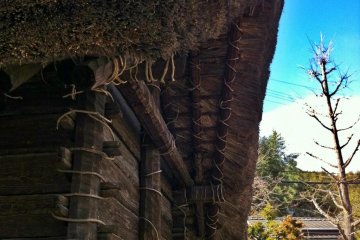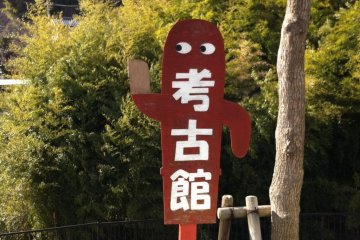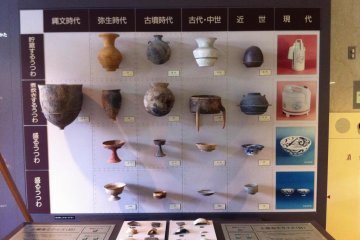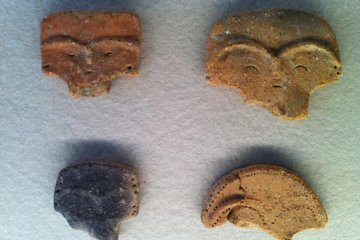Matsuyama’s Sogo Koen, which means ‘general park’, is located on a tall and expansive hill between the city center and the airport. Paved roads and pathways loop this way and that throughout the park, linking the various facilities and free parking areas. The southwest corner of the park is home to the Matsuyama City Archaeological Museum which stands overlooking a small lake. Slightly creepy haniwa signposts point the way with just their eyes. Haniwa are the simple, pessary-shaped clay figurines from Japan’s ancient Kofun period, when the aristocracy were buried in mounds called kofun. Many of these are to be found in Matsuyama.
The Archaeological Museum is housed in a grand modern building. As you approach it round the lake from the car park, you come across a reconstruction of a burial mound and an ancient granary. The granary is interesting for its cunningly interlocked wall panels, fixed with a binding of thick vine, and the flat projections on its stilts to prevent vermin climbing up.
Entrance to the museum itself is free, although entry to the occasional special exhibitions costs 200 yen. There's another facility up the hill to the right of the museum, but there's nothing to see there, so you can happily skip it.
The main focus of the museum is pottery and there’s a wide variety of surprisingly sophisticated kitchenware. An exhibit in the lobby compares today’s kitchenware with real examples from various periods in ancient history. Other exhibits include displays of agricultural implements, burial practices, and the remains of a wooden dam from the 4th century. Today, the Japanese are hotly debating their reliance on dams, and so it would certainly be true to say that old ways die hard.
Although the exhibits are labeled only in Japanese, considerable effort has been made to put them into some visual context that can be understood without language. Many of the exhibits are simply beautiful in their own right, and as such are worth looking at. You can get a pamphlet in several languages at the counter which gives a good overview of the exhibits.
While the ancient dining ware will probably be of interest to most adults, provision is made for children in the form of a little prehistoric play area where kids can dress up in animal skins and padded prehistoric armor. The vivid diorama of the Stone Age family in their prehistoric hut also presents a good opportunity to explain to the kids how tough things used to be when their parents were young.













